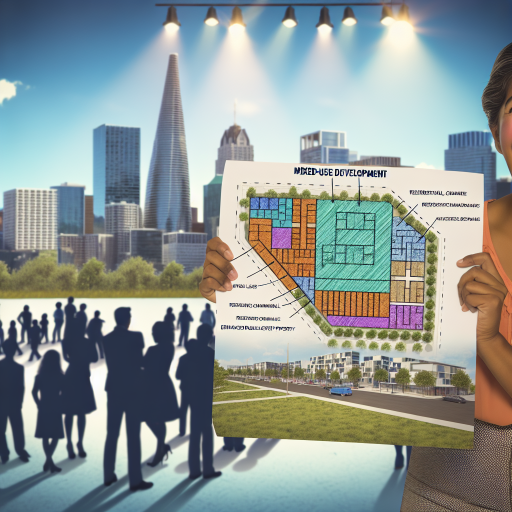Overview of Zoning Laws and Their Purpose in Urban Planning
Zoning laws play a crucial role in shaping urban environments.
These laws regulate land use and development within municipalities.
Essentially, they serve to segregate different types of activities.
The primary goal is to promote organized growth in urban areas.
Moreover, zoning laws aim to protect public health and safety.
They ensure that residential areas are safe and livable.
Additionally, these laws enhance the aesthetic value of neighborhoods.
They help maintain property values by controlling development density.
The Classification of Zoning Laws
Zoning laws typically categorize areas into various zones.
Common types of zones include residential, commercial, and industrial.
Residential zones primarily focus on housing and related amenities.
Commercial zones accommodate businesses and retail activities.
Industrial zones are designated for manufacturing and heavy industries.
Mixed-use zones combine different functionalities within the same area.
Regulatory Aspects of Zoning Laws
Municipal governments enforce zoning regulations through ordinances.
Transform Your Real Estate Decisions
Unlock personalized real estate insights crafted just for you. Get actionable advice designed to amplify your success.
Get StartedThese regulations outline specific requirements for land use.
They also determine building heights, setbacks, and densities.
Furthermore, zoning laws may include environmental protection measures.
Such measures ensure that development does not harm natural resources.
The Importance of Zoning Laws in Urban Planning
Zoning laws are vital for effective urban planning and management.
They help to configure transportation and infrastructure efficiently.
Proper zoning can lead to reduced traffic congestion.
It also contributes to more sustainable development patterns.
Therefore, understanding these laws is crucial for developers and policymakers.
Types of Zoning Laws
Residential Zoning
Residential zoning regulates areas designated for housing.
This type often dictates the types of homes allowed.
For example, single-family homes may be preferred.
Multi-family units might face restrictions in certain zones.
Also, residential zoning impacts community density.
Showcase Your Real Estate Business
Publish your company profile on our blog for just $200. Gain instant exposure and connect with a dedicated audience of real estate professionals and enthusiasts.
Publish Your ProfileHigher density may lead to more housing units.
Ultimately, these zones shape neighborhood character.
Commercial Zoning
Commercial zoning establishes areas for business activities.
This type includes retail shops, offices, and services.
Different zones may limit types of businesses within them.
For instance, a commercial zone may restrict manufacturing.
These laws influence economic development in communities.
Additionally, they affect traffic patterns and accessibility.
Industrial Zoning
Industrial zoning focuses on areas designated for manufacturing and heavy industry.
This type allows factories and warehouses to operate legally.
It often includes specific use permits for operations.
These areas may be located away from residential zones.
Moreover, they can impact local employment rates.
Industrial zones help local economies thrive through job creation.
Mixed-Use Zoning
Mixed-use zoning combines residential, commercial, and sometimes industrial uses.
It encourages diverse development within a single area.
This type promotes walkability and reduces transportation needs.
Mixed-use developments foster community interaction.
However, they may require careful planning and regulation.
Conflicts can arise if businesses disrupt residential living.
The Historical Evolution of Zoning Laws in the United States
Early Development of Zoning Laws
Zoning laws in the United States began to take shape in the early 20th century.
In 1916, New York City implemented the first comprehensive zoning resolution.
This law aimed to separate residential areas from industrial zones.
Consequently, it sought to enhance public health and safety.
Expansion of Zoning Practices
During the 1920s, many cities adopted similar zoning laws.
City planners recognized the need to manage urban growth effectively.
This period marked a significant shift in land use regulation.
Furthermore, zoning laws sought to uphold property values.
Impact of the Great Depression
The Great Depression in the 1930s hindered new zoning initiatives.
Financial constraints delayed many urban development projects.
Showcase Your Real Estate Business
Publish your company profile on our blog for just $200. Gain instant exposure and connect with a dedicated audience of real estate professionals and enthusiasts.
Publish Your ProfileHowever, zoning remained crucial for organizing land use.
Cities continued to enforce existing regulations during this era.
Post-World War II Changes
After World War II, suburbanization accelerated across the nation.
Zoning laws adapted to accommodate new housing developments.
This era saw the rise of single-family residential zones.
Consequently, urban sprawl increased as cities expanded outward.
Modern Zoning Challenges
Today, zoning laws face criticism for limiting housing supply.
Many argue they contribute to the affordable housing crisis.
Moreover, restrictive zoning can exacerbate economic inequality.
In response, some cities are reforming their zoning practices.
These reforms aim to promote inclusivity and sustainability.
Learn More: How Technology Is Shaping Homebuyer And Seller Market Expectations
Impact of Zoning Laws on Housing Supply and Affordability
Understanding Zoning Laws
Zoning laws regulate land use in specific areas.
These laws determine where residential, commercial, and industrial buildings can be constructed.
They also control the density of development and the types of buildings allowed.
Moreover, zoning laws aim to promote orderly development and community character.
Influence on Housing Supply
Zoning laws significantly affect the housing supply in a community.
Strict zoning regulations can limit the number of available housing units.
For example, residential zoning may restrict multi-family dwellings.
Consequently, this leads to a shortage of affordable housing options.
Conversely, more permissive zoning can encourage diverse housing developments.
Impact on Affordability
The relationship between zoning laws and housing affordability is critical.
When supply is limited, housing prices tend to rise.
This often makes housing unaffordable for many households.
Additionally, zoning laws that favor single-family homes may exacerbate the issue.
As a result, low- and middle-income families struggle to find suitable housing.
Case Studies of Zoning Law Effects
Various cities exhibit different outcomes based on their zoning laws.
In San Francisco, strict zoning has led to skyrocketing housing prices.
On the other hand, Portland has adopted more flexible zoning practices.
This has resulted in a more balanced housing market with options for all income levels.
Showcase Your Real Estate Business
Publish your company profile on our blog for just $200. Gain instant exposure and connect with a dedicated audience of real estate professionals and enthusiasts.
Publish Your ProfileThus, the impact of zoning laws on housing differs significantly by location.
Strategies for Reforming Zoning Laws
Many experts advocate for zoning reform to improve housing supply.
One strategy is to relax zoning restrictions on density.
This enables developers to build more housing units in desirable areas.
Additionally, reducing regulatory barriers can expedite the construction process.
Encouraging mixed-use developments can also provide diverse housing options.
Future Considerations
As urban populations grow, the need for effective zoning reforms is crucial.
Policymakers must balance community interests with the need for affordable housing.
Innovative zoning solutions can help adapt to changing housing demands.
Ultimately, thoughtful zoning can enhance both supply and affordability.
Discover More: How Economic Factors Impact the Housing Market in Different States
Case Studies of Cities with Restrictive Zoning
San Francisco
San Francisco has stringent zoning laws affecting residential development.
The zoning restrictions reduce the supply of new housing units.
This situation leads to increased housing prices in the city.
Many residents face affordability challenges due to high costs.
Studies indicate that the population growth outpaces housing supply.
As a result, long-time residents often feel displaced.
New York City
New York City also implements strict zoning regulations across its boroughs.
Mixed-use zoning laws limit the construction of affordable housing.
Consequently, this exacerbates the city’s housing affordability crisis.
In some neighborhoods, zoning contributes to overcrowded living conditions.
The vibrant population continues to grow, increasing housing demand.
Yet, the supply of housing fails to keep pace with this demand.
Los Angeles
Los Angeles grapples with zoning laws that hinder new development.
These laws prioritize single-family homes over multi-family units.
As a result, constrained housing supply leads to higher rents.
The city’s diverse population struggles to find affordable options.
Despite the need for more housing, development often faces community opposition.
This results in lengthy approval processes for new projects.
Seattle
Seattle has recently faced housing supply issues due to restrictive zoning.
Showcase Your Real Estate Business
Publish your company profile on our blog for just $200. Gain instant exposure and connect with a dedicated audience of real estate professionals and enthusiasts.
Publish Your ProfileIn some areas, zoning regulations limit building height and density.
This restricts the number of homes that can be built, worsening shortages.
The city has seen rapid job growth, increasing housing demands.
However, the release of new housing is insufficient to accommodate this influx.
Many residents express frustration over rising living expenses.
Impacts of Restrictive Zoning on Housing Markets
Each city’s restrictive zoning laws illustrate the broader impacts on housing markets.
Housing shortages lead to increased prices across these urban areas.
Lawmakers must evaluate how to balance zoning regulations with housing needs.
Evidence shows changes in zoning can alleviate some affordability issues.
Ultimately, comprehensive solutions require collaboration between communities and governments.
Learn More: A Deep Dive Into Regional Housing Market Trends for Investors

The Role of Zoning Laws in Shaping Urban Density and Land Use
Introduction to Zoning Laws
Zoning laws regulate land use in urban areas.
They determine what types of buildings can exist in specific locations.
Furthermore, these laws impact community development and planning.
Types of Zoning Laws
There are various types of zoning regulations.
Residential zoning restricts areas for housing developments.
Commercial zoning allows for business operations in designated regions.
Industrial zoning designates land for manufacturing and production facilities.
The Impact on Urban Density
Zoning laws play a crucial role in urban density management.
They influence how much housing can fit within a specific area.
Increased density can lead to more efficient land use.
However, it can also strain public services and infrastructure.
Factors Affecting Land Use
Several factors influence how zoning decisions are made.
Community needs and growth trends significantly impact these laws.
Additionally, environmental considerations shape zoning regulations.
Equally important are economic factors, including property values.
Challenges of Zoning Laws
Zoning laws can inadvertently create housing shortages.
Strict zoning regulations often limit available land for development.
This restriction can increase housing prices and limit options.
Moreover, outdated zoning laws may fail to meet modern needs.
Showcase Your Real Estate Business
Publish your company profile on our blog for just $200. Gain instant exposure and connect with a dedicated audience of real estate professionals and enthusiasts.
Publish Your ProfileAdapting Zoning Laws for Future Needs
City planners are increasingly re-evaluating zoning regulations.
Flexibility in zoning can promote mixed-use developments.
This approach encourages more vibrant communities with diverse services.
Moreover, it can help address issues of housing affordability.
Find Out More: Key Factors Impacting Homebuyer Negotiation Power In Today’s Market
Challenges and Controversies Surrounding Zoning Reforms
Public Opposition to Changes
Zoning reforms often face strong public opposition.
Residents typically fear changes will alter neighborhood character.
This concern leads to organized protests and petitions.
Moreover, misinformation can fuel public anxiety.
In many cases, communities feel excluded from decision-making.
Economic Implications
Zoning reforms can significantly impact local economies.
Developers may resist projects due to increased costs.
Moreover, stricter zoning can limit housing supply.
- Increased housing costs can lead to affordability crises.
- Limited supply often contributes to homelessness.
Understandably, stakeholders want to balance development and community needs.
Equity and Inclusion Concerns
Zoning laws can perpetuate inequality in housing access.
Exclusionary zoning restricts affordable housing options.
This practice often affects low-income families disproportionately.
Many advocates call for inclusive zoning policies.
- Inclusive policies aim to create mixed-income communities.
- Such policies promote diversity and social equity.
Legal and Administrative Challenges
Navigating zoning law changes can be complex.
The legal framework often hinders swift reforms.
Local governments may struggle with bureaucratic inefficiencies.
Resistance from established interests can further complicate reforms.
Coordination among different governmental levels is often necessary.
Balancing Development and Preservation
Communities face the challenge of balancing growth with preservation.
Environmental concerns play a critical role in zoning discussions.
Preserving green spaces is crucial for urban areas.
However, developers view such limitations as impediments.
Ultimately, finding common ground is essential for progress.
Future Trends in Zoning Laws and Their Potential Effects on Housing Markets
Emerging Zoning Reforms
Many jurisdictions are exploring new zoning reforms to address housing shortages.
These reforms aim to promote density and affordability in urban areas.
Showcase Your Real Estate Business
Publish your company profile on our blog for just $200. Gain instant exposure and connect with a dedicated audience of real estate professionals and enthusiasts.
Publish Your ProfileFor instance, inclusionary zoning mandates set aside affordable units in new developments.
This practice enhances access to housing for low-income families.
Downzoning and Its Implications
In contrast, downzoning restricts development intensity in certain neighborhoods.
This trend can limit housing availability in desirable areas.
Nonetheless, it may preserve community character and reduce overcrowding.
Balancing these factors will be crucial for local governments.
Increased Flexibility in Land Use
Future zoning laws may allow mixed-use development in more areas.
This flexibility can foster vibrant neighborhoods and reduce commute times.
Moreover, it promotes small businesses alongside residential spaces.
Consequently, such developments contribute positively to local economies.
Impact of Technology on Zoning
Technological advancements will influence zoning practices significantly.
Smart city initiatives may integrate zoning laws with real-time data.
This integration can optimize land-use strategies based on community needs.
Additionally, it allows for adaptive zoning measures in response to changing conditions.
Potential Effects on Housing Costs
Changes in zoning laws will likely impact housing costs across the board.
Increased housing supply may lead to lower prices in some markets.
However, high-demand areas could see prices rise due to limited zoning changes.
As a result, local governments must navigate these complexities thoughtfully.
Community Engagement in Zoning Changes
Engaging communities in zoning law discussions is essential for success.
Stakeholder input can lead to more equitable and effective policies.
Furthermore, transparent processes can build trust among residents.
Ultimately, community engagement fosters sustainable development outcomes.
Additional Resources
California’s High Housing Costs: Causes and Consequences
Zoning, Land-Use Planning, and Housing Affordability | Cato Institute




